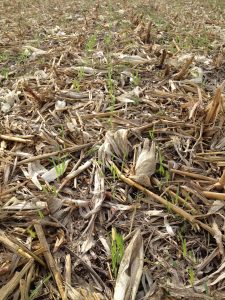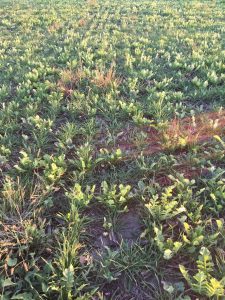Keep the Soil Covered
By Rolf Derpsh, Ph.D, Asunción, Paraguay
The first step towards soil health is to protect your soil with cover or residue, oftentimes referred to as “soil armor”. In addition to preventing wind and water erosion, covered soil has far fewer weeds, much higher infiltration, and much lower evaporation. Rolf Derpsch, one of the fathers of the South American No-till and Soil Health movement, has this to say about Soil Cover:
 Not very many farmers understand the true importance of soil cover in the no-till system. Some even wrongly view crop residues as a commodity, waste product, or an impediment to seeding the next crop. A no-till system with low amounts of crop residues, limited crop diversity, and high amounts of soil disturbance will have higher evaporation rates, lower water-use efficiency, and will not attain the full potential of the no-tillage system. Almost all the benefits and advantages of the notill system come from the permanent cover of the soil and only a few from not tilling the soil. In other words, it is not so much the absence of tillage, but the presence of crop residues on the soil surface that results in a better performance of no-till in comparison to tilled systems. Failure to pay attention to soil cover has resulted in poor performance of the system (lower yields, increased runoff and erosion, low biological activity, etc.). There is plenty of scientific evidence that no-tillage without soil cover results in poor crop yields.
Not very many farmers understand the true importance of soil cover in the no-till system. Some even wrongly view crop residues as a commodity, waste product, or an impediment to seeding the next crop. A no-till system with low amounts of crop residues, limited crop diversity, and high amounts of soil disturbance will have higher evaporation rates, lower water-use efficiency, and will not attain the full potential of the no-tillage system. Almost all the benefits and advantages of the notill system come from the permanent cover of the soil and only a few from not tilling the soil. In other words, it is not so much the absence of tillage, but the presence of crop residues on the soil surface that results in a better performance of no-till in comparison to tilled systems. Failure to pay attention to soil cover has resulted in poor performance of the system (lower yields, increased runoff and erosion, low biological activity, etc.). There is plenty of scientific evidence that no-tillage without soil cover results in poor crop yields.
 Contrary to the belief of many US Farmers, there is no need to till the soil every so often after a notill system has been established. Good examples are South American farmers, who once started, never till the soil again. The best way to avoid compaction is to produce maximum amounts of soil cover and to use cover crops and crop rotations. This way the roots and biological activity, as well as earthworms and insects, etc. will loosen the soil along with substances like Glomalin that bind the soil particles into stable aggregates and result in a beneficial soil structure.
Contrary to the belief of many US Farmers, there is no need to till the soil every so often after a notill system has been established. Good examples are South American farmers, who once started, never till the soil again. The best way to avoid compaction is to produce maximum amounts of soil cover and to use cover crops and crop rotations. This way the roots and biological activity, as well as earthworms and insects, etc. will loosen the soil along with substances like Glomalin that bind the soil particles into stable aggregates and result in a beneficial soil structure.
Cover crops and crop rotation play a very important role in a no-till system in order to achieve the high amounts of soil cover needed. The development of cover cropping along with a permanent no-till system has been a major factor in the unprecedented growth of this technology in South America. In drier climates, farmers are often concerned that cover crops will take moisture out of the soil, making it unavailable for the primary crops. This is and should always be a concern in drier climates. Managing cover crops at the right time, in the right way, and using species that use less moisture are ways of getting around this problem. It must be remembered that while the cover crop removes some soil moisture, the additional mulch from the cover crop will improve water-use efficiency later in the cash crop.
Additional Links
- 5 Soil Health Principles – In this article, North Dakota soil health expert, Jay Fuhrer does a great job introducing all five of the Principles of Soil Health.
-
Soil Armor – Jay Furhrer explains why Soil Armor is important in this 5 minute video clip from the Menoken Farm.
This article first appeared in our “Keepin’ You Covered” email newsletter where we share 1 soil health topic, 2 success stories and 3 learning opportunities.
If you’re excited to learn more, sign up for our bi-monthly newsletter here.